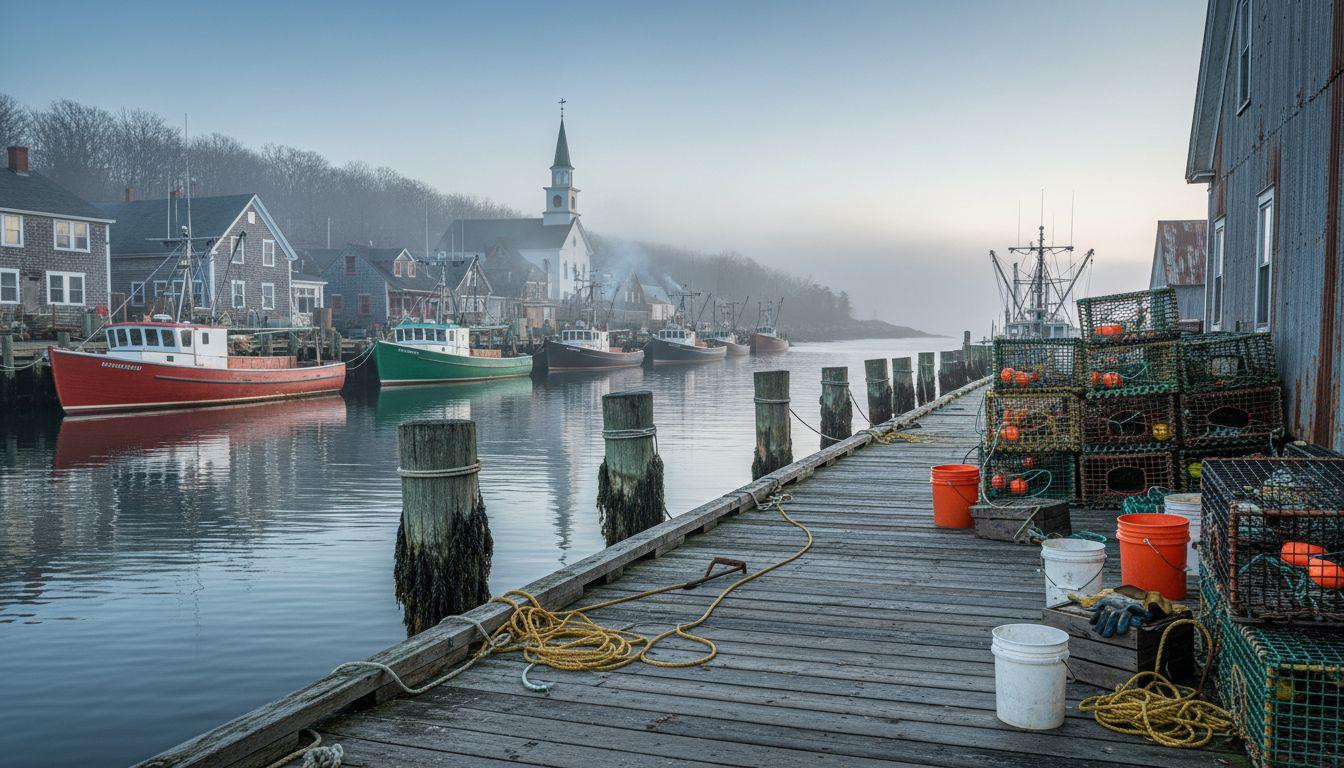Morning fog rolls across Boothbay Harbor like a gray blanket, muffling the sound of diesel engines warming up at 5:30 AM. By 7 AM, the mist begins its slow retreat, revealing weathered lobster boats preparing for another day on the Gulf of Maine. This is Maine’s most authentic working harbor, where fishing schedules dictate the rhythm long after summer tourists have departed.
November brings a clarity that summer crowds obscure. The harbor operates on fishermen’s time now, not vacation schedules.
Where fishing schedules replace tourist hours
Boothbay Harbor sits 50 miles northeast of Portland, jutting into the Gulf of Maine on a protected peninsula that has sheltered fishing vessels for centuries. The town maintains its working character through Maine’s harsh seasons, unlike coastal communities that close their shutters after Labor Day.
Drive the winding Route 27 through November’s bare hardwood forests, and you’ll find most seasonal businesses locked tight. But the harbor itself never sleeps. Lobster boats crowd the docks, their rust-red and forest-green hulls bobbing against weathered pilings that creak with each tide change.
This temporal shift creates unexpected access. The waterfront cafes serving fishermen at dawn remain open, while tourist-focused shops stand empty. Walking the harbor at 6 AM in November means witnessing authentic maritime commerce without the buffer of Victorian houses emerge from Atlantic fog as morning wind clears this Maine harbor.
When fog lifts the harbor reveals itself
The atmospheric transformation happens gradually. Fog reduces visibility to perhaps 200 feet, creating an intimate world bounded by gray water and muffled sounds. Then the northeast wind picks up, and the harbor’s true character emerges piece by piece.
The Atlantic gray palette
Weathered cedar shingles cover most buildings, their silver-gray surfaces darkened by decades of salt spray. White church steeples punctuate the skyline, while lobster traps stacked 6 feet high create geometric patterns in rust, yellow, and green. This isn’t picture-postcard Maine but working Maine, honest about its maritime economy.
The sound of real commerce
Rigging clangs against aluminum masts in the morning breeze. Diesel engines rumble to life, their exhaust visible in the cold air. Dock lines strain and snap taut with each wave. Seagulls cry overhead, diving for bait scraps as fishermen prepare their gear for 12-hour days on the water.
The November experience locals keep quiet
Tourism data shows 85% fewer visitors in November compared to July peaks. This dramatic drop reveals Boothbay Harbor’s genuine personality, stripped of its summer performance.
Early morning harbor walks
Arrive at the waterfront by 6:30 AM to witness the daily departure ritual. Lobstermen load fresh bait, check GPS units, and motor out through the harbor mouth toward their offshore territories. Steam rises from coffee cups at the dockside cafe that opens at 5 AM for the fishing fleet.
The harbor walkway stretches better than Traverse City where hotels cost $285 nightly, this Lake Erie harbor town has working fishing boats and costs $140 less. November temperatures hover around 42°F, requiring layers but rewarding early risers with solitude.
Dock-side authenticity
Fish processing facilities operate year-round, their corrugated metal buildings revealing glimpses of the day’s catch being sorted and iced. Lobster pounds maintain live inventory in saltwater tanks fed by harbor water. Boat maintenance happens in real time, with engines being repaired and nets mended on working docks accessible to curious visitors.
The details that matter
November accommodation rates drop to $80-140 per night at year-round properties, compared to $200-350 during summer peaks. The Botanical Gardens’ Gardens Aglow display begins just before Thanksgiving, creating winter appeal beyond the maritime focus.
Daylight ends before 4:30 PM, concentrating activity into compressed morning hours. Weather requires waterproof layers and warm boots, but rewards include brilliant light when fog clears and Edenton’s 1886 lighthouse doubles in brackish water creating America’s last rectangular screw pile reflection at dawn.
The fishing industry operates through Maine’s coldest months. Water temperature holds steady around 46°F, compared to summer highs near 65°F.
Your questions about Boothbay Harbor answered
Is November too cold for Boothbay Harbor?
November temperatures average 42°F during the day and 32°F at night. The coastal location moderates extreme cold, though fog and dampness require appropriate clothing. Clear November days offer exceptional visibility across the Gulf of Maine, with fewer crowds than warmer months.
What’s actually open in November?
Year-round restaurants serve the fishing community, typically opening at 5 AM for the fleet. The Opera House maintains winter programming. Approximately 40% of summer businesses close seasonally, but essential services and authentic maritime operations continue. Several inns remain open with reduced rates.
How does this compare to Bar Harbor off-season?
Bar Harbor, 150 miles northeast, experiences more complete seasonal shutdown due to its tourism-dependent economy. Boothbay Harbor’s working character means continuous activity through winter months. 8 autumn cities where thermal baths and wine harvests cost 60% less than summer peaks provide alternative seasonal destinations.
Dawn breaks over Boothbay Harbor at 7:15 AM on November 25th, painting the working waterfront in pale gold light that penetrates the last wisps of retreating fog. The harbor awakens to another day measured in tides and catches rather than check-ins and departures.
